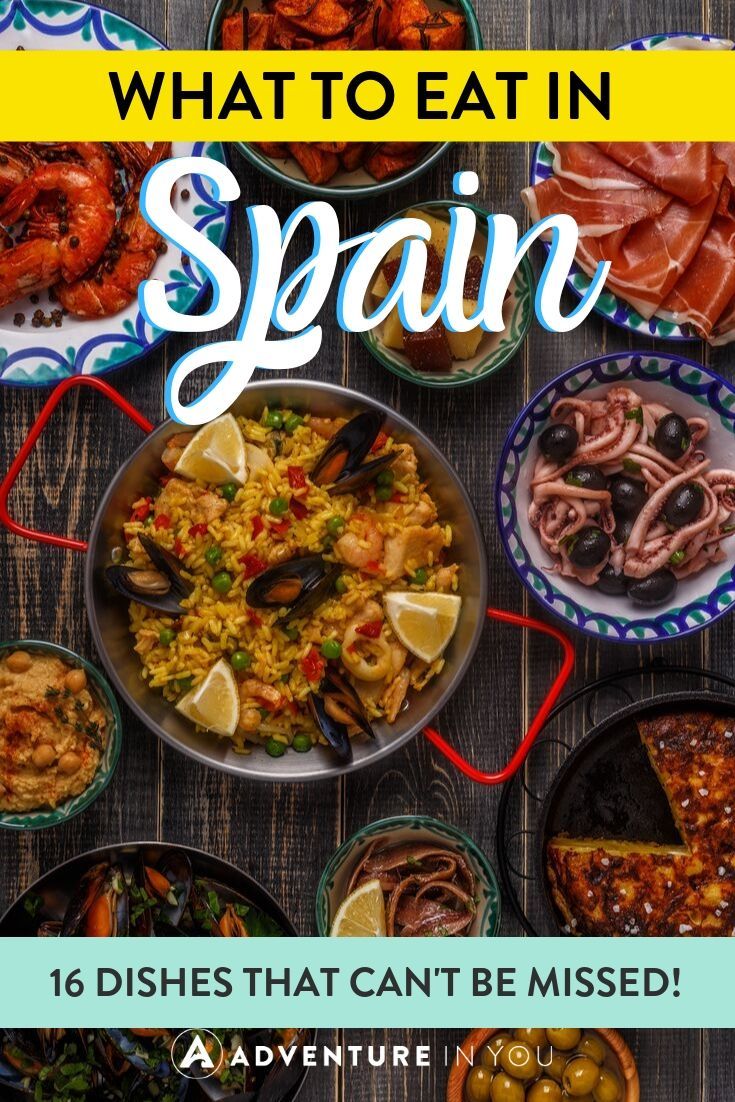Wondering what to eat in Spain? Look no further as in this article, I give you the deepdive on Spanish food and culture. As far as European food goes, Spain really knocks it out of the park. It’s well-known across the world for its family-style portions, lively dining culture, and bites so delicious they’ll make your head spin.
There’s no single standard when it comes to Spanish food. Instead it’s a melting pot of flavors, spices, seafood, meats and vegetables. In simple terms, there’s no better way to enjoy Spain than eating your way through it.
To help you along your feasting journey, here’s everything you need to know about Spanish food, what to eat in Spain, and tips for dining in the land of bite-sized morsels.
View Contents
What is Spanish Food Like?
Spanish food comes in all flavors, shapes, styles and sizes. You’ll never find two dishes that taste the same (or even similar), keeping endless surprises for those bold enough to try all of the specialties this country has to offer.
The massive variety in Spanish food comes mostly from the fact that every region has their own style of cuisine and each area has spent centuries perfecting their famed dish.
You can find regional delicacies throughout Spain, and it’s definitely worth traveling to a specific place if there’s a dish you can’t stop dreaming about.
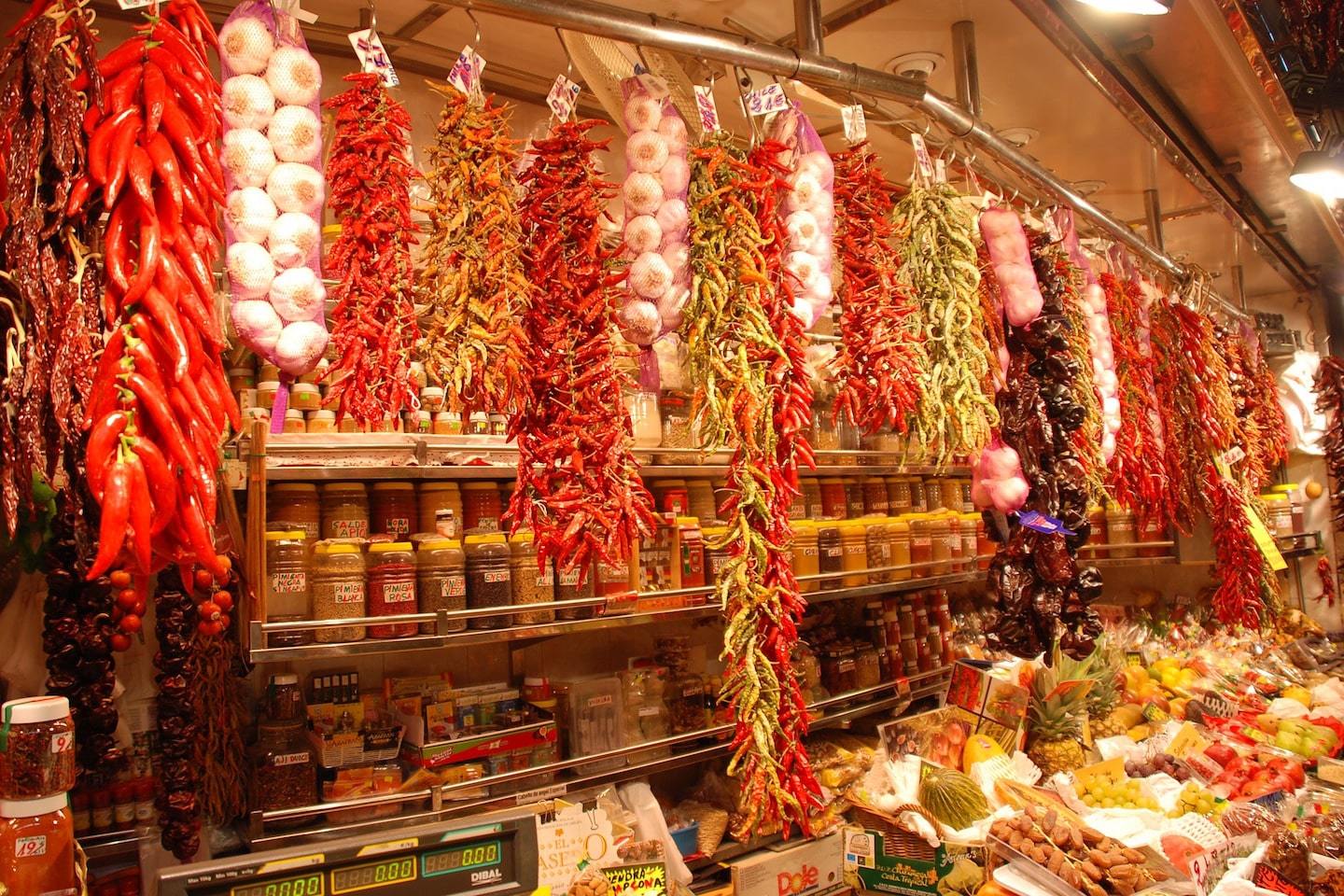
You’ll typically find that Spanish food isn’t spicy, but it’s always bursting with unique flavors and seasoning. Generally, Spanish cooking uses loads of garlic, paprika, and rarities like saffron and squid ink, that make the flavors of the dish pop even more.
Speaking of squid ink, when it comes to Spanish food, seafood is king. With a seemingly endless coastline, it’s no wonder there’s an absolute abundance of fresh fish, squid, octopus, shrimp, clams, mussels, and more!
Finally, and most importantly, Spanish food is generally served family-style.
The most common form of family-style meals is tapas, which is basically just a bite of something delicious. The portions are small so you order a ton to eat and share, which is amazing because it gives you the opportunity to try a little bit of everything!
In the Basque region, you’ll find pintxos: their version of tapas. It’s usually laid out as a giant spread of toasts with spreads and other small bites which you can help yourself to. It’s simply divine.
On the other end of the spectrum, sometimes Spanish dishes come in giant vats that look as if they could serve an army. Specialties like paella are meant to be shared among many, rather than eaten by a single person.
Eating in Spain is all about community. Whether it’s the community of origin or the community which you’re enjoying the meal with, Spanish food brings people from far and wide together around one table.
✨The 1 Thing We Never Leave Home Without…✨

Coming from someone who has been traveling the world for the last 8 years AND has been in the hospital 2x, travel insurance is something everyone NEEDS to get. Get a quote below!
What to Eat in Spain
The simple answer to the question “what to eat in Spain” is “absolutely everything.”
But if you’re looking for more specific dishes, here are 16 must-try items for your Spanish holiday.
Paella
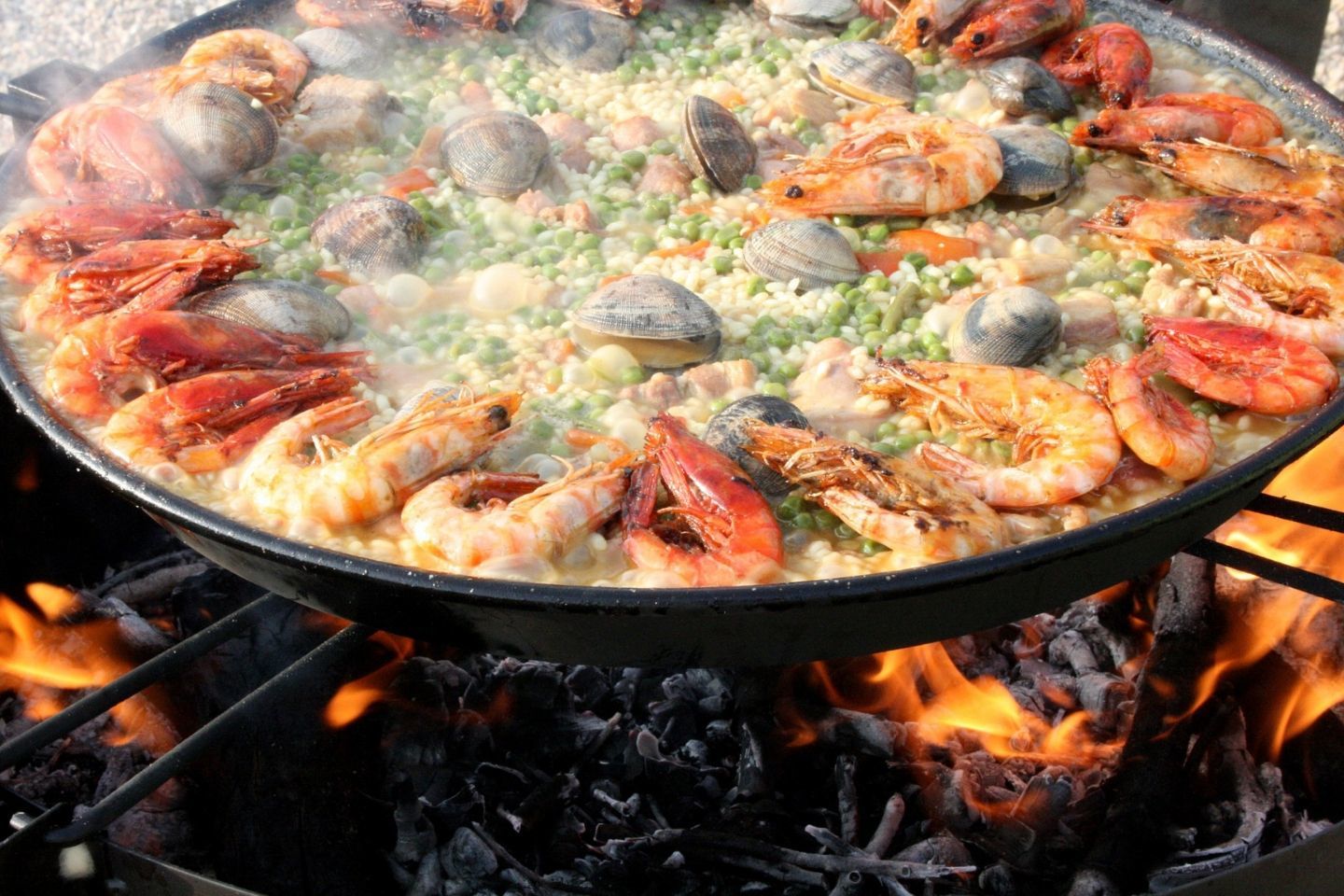
First thing’s first: when in Spain, paella is an absolute must. As the most famous rice dish in the country, paella is a traditional meal that’s meant to be shared among friends and family members.
As it originated in Valencia, you can’t miss a huge helping of it if you’re passing through the city. It’s served in every restaurant, and also in smaller portions at local markets as well!
Paella comes in many different styles and flavors, but is almost always served in a deep iron skillet with tons of goodies inside.
You can find Paella Valenciana which is typically white rice with veggies, chicken, duck and rabbit. Seafood Paella is filled with all sorts of sea creatures and seasoning, while Paella Mixta with a combination of meat and seafood.
Certain places also serve a special Arroz Negro which is essentially black-colored paella from squid ink and is absolutely delectable. Just know that no matter which paella you choose, you won’t be disappointed!
If you’re looking for fun things to do in Barcelona, a cooking class or food tour is high up on our list.
Speaking of Barcelona, if you happen to find yourself in that beautiful city, this Paella Cooking class is AMAZING.
Tortilla Española

One of my personal favorites, tortilla española cannot be missed when you’re in Spain. This Spanish-style omelet is often included on tapas menus (or as a standalone dish) as it’s a favorite all across the country.
Besides egg, you also find potatoes, onion and a generous helping of salt and pepper in this unbeatable snack.
Tortilla española can come in different forms. Sometimes it’s a thick, fluffy pancake while other times you’ll find it’s thinner and a bit softer. Regardless of the shape and texture, it’s delicious and one of the most common dishes in Spain!
Patatas Bravas

Speaking of most common dishes in Spain, patatas bravas is right up there on the list. Think diner-style home fries with this one, except tapas style.
These crispy little potatoes are absolutely smothered in different sauces, and are often eaten with a toothpick. Where you get your patatas determines the sauce but it’s always so delicious you’ll find your mouth watering for more!
Pimientos de Padron
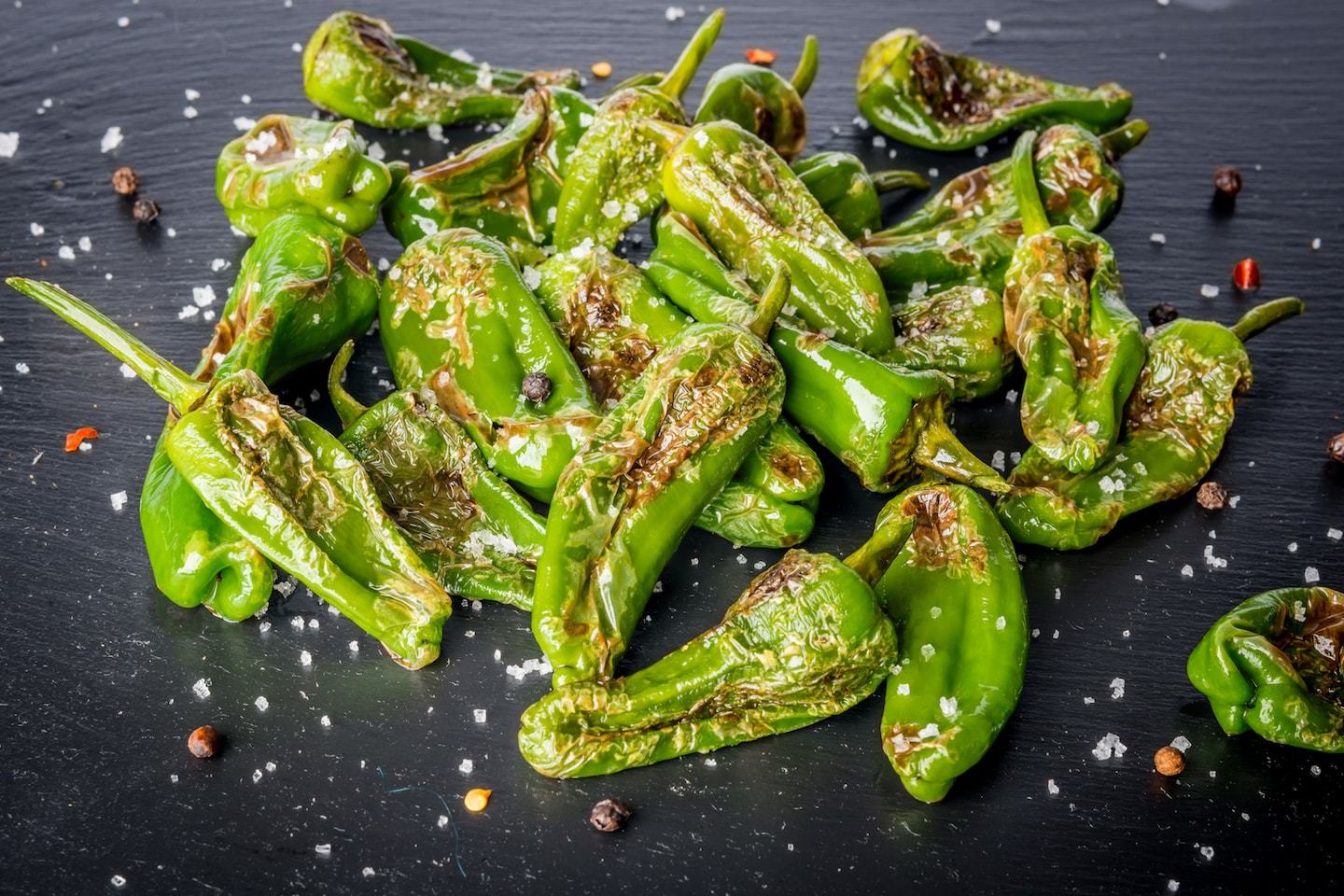
Although Spanish food is mouthwatering good, it’s rarely spicy, which is why it’s such a treat to see locals snacking on these blistered little peppers.
Served as tapas, these green peppers from Galicia are generally fried with olive oil and covered with sea salt for some flavor. Only 15% of them are spicy, so it’s a nice (or shocking) surprise when you come across that rare one with a bit of a kick!
Croquetas
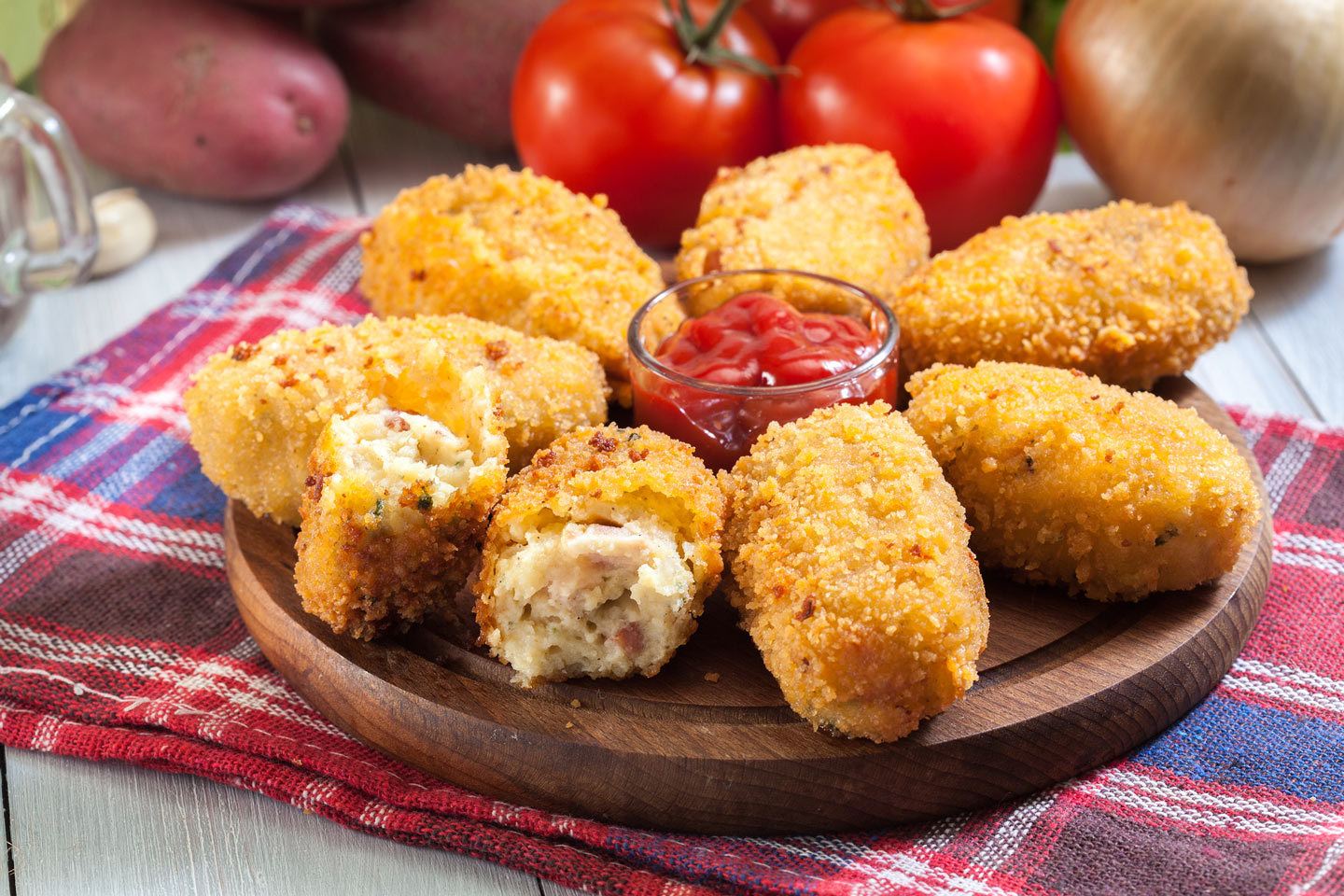
There’s nothing quite like a Spanish croqueta, and biting into one is like a little taste of deep-fried heaven.
These crispy balls are generally filled with bechamel sauce and other ingredients like jamon, ground meat, fish, seafood, or vegetables. They’re awesome as a snack and even better as tapas.
You’ll quickly realize that every place serving them has their own unique twist on this Spanish specialty!
Grilled Octopus

With 5,000 miles of coastline, it’s no wonder Spain is swimming in seafood.
One of the best tastes of the wide open ocean is grilled octopus, or Pulpo a la Gallega. A tapas bite or a full main dish, this simple seafood specialty is typically just grilled with paprika and olive oil, keeping it nice and delicious.
Instead of being chewy like typical octopus dishes, this Spanish take is extremely tender and usually served on wooden plates. It’s extra succulent and beyond delicious, practically melting in your mouth.
Even if you’re not a seafood lover, this is a must-have while in Spain.
Gambas Ajillo
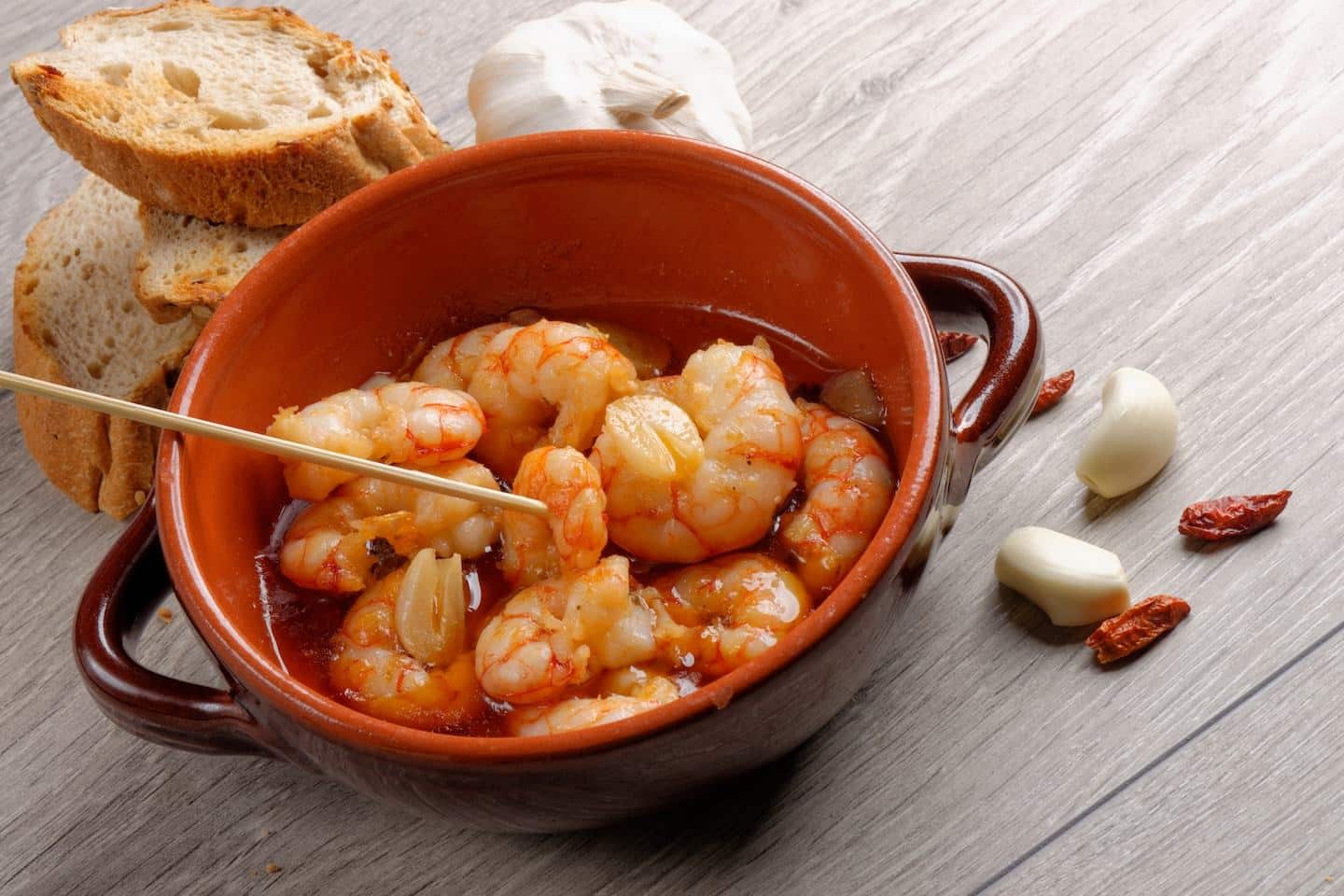
Another cannot be missed seafood specialty is gambas ajillo, or garlic shrimp.
These sizzling bad boys are most popular in the south of Spain (I ate a lot of this in Malaga) but it can be found on tapas menus far and wide across the country. With an order, you get a fair helping of shrimp soaking in olive oil and garlic with the occasional sprinkle of paprika, lemon juice, and of course some parsley.
They’re so good, it’s insane. But the best part is dipping your bread in the leftover juice once all the shrimp are gone!
Gazpacho

Coming all the way from Andalusia, gazpacho is another Spanish staple that can come in tons of different styles and flavors. Every place you eat in Spain will probably have a gazpacho recipe of their own, but you can bet they’ll be consistent with a few key ingredients.
The most typical you’ll find is a cold soup made of tomatoes, cucumbers, garlic, onion, olive oil, a touch of vinegar and salt. But gazpacho can also be served warm, as a salad or stew, with ham, croutons or extra veggies. The possibilities are endless!
No matter what, gazpacho is always a refreshing bite on a warm day in southern Spain.
Pisto
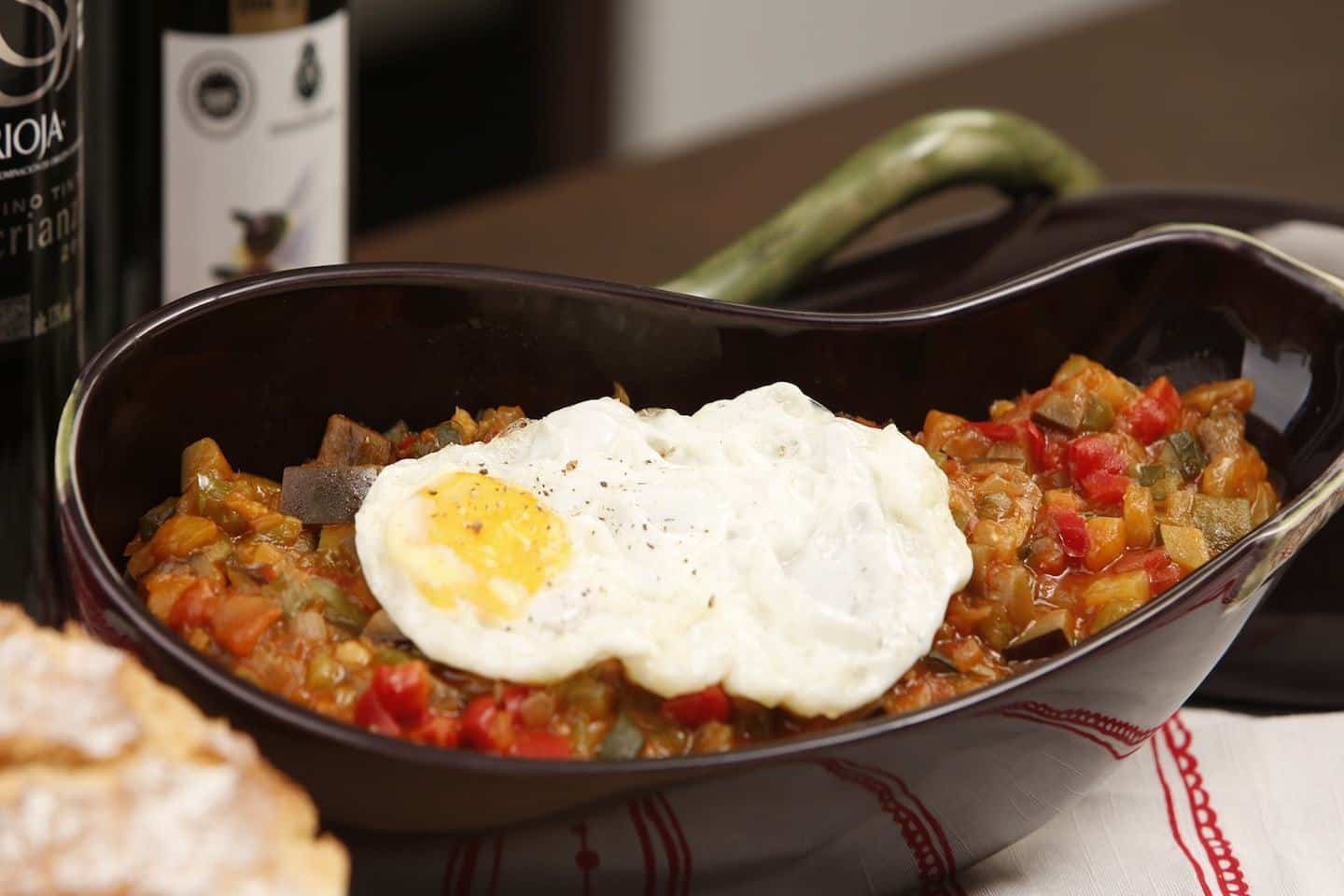
Essentially Spanish ratatouille, this hearty dish is jam-packed with all the veggies you could imagine. You’ll typically find it full of eggplant, tomato, onion, bell peppers, and olive oil.
But best of all? It’s topped with a fried egg and chorizo!
This is an ideal dish for vegetarians (hold the chorizo, por favor!) having a hard time finding something meat-free while traveling. It’s eaten as a full meal rather than just a tapas bite.
Bocadillos
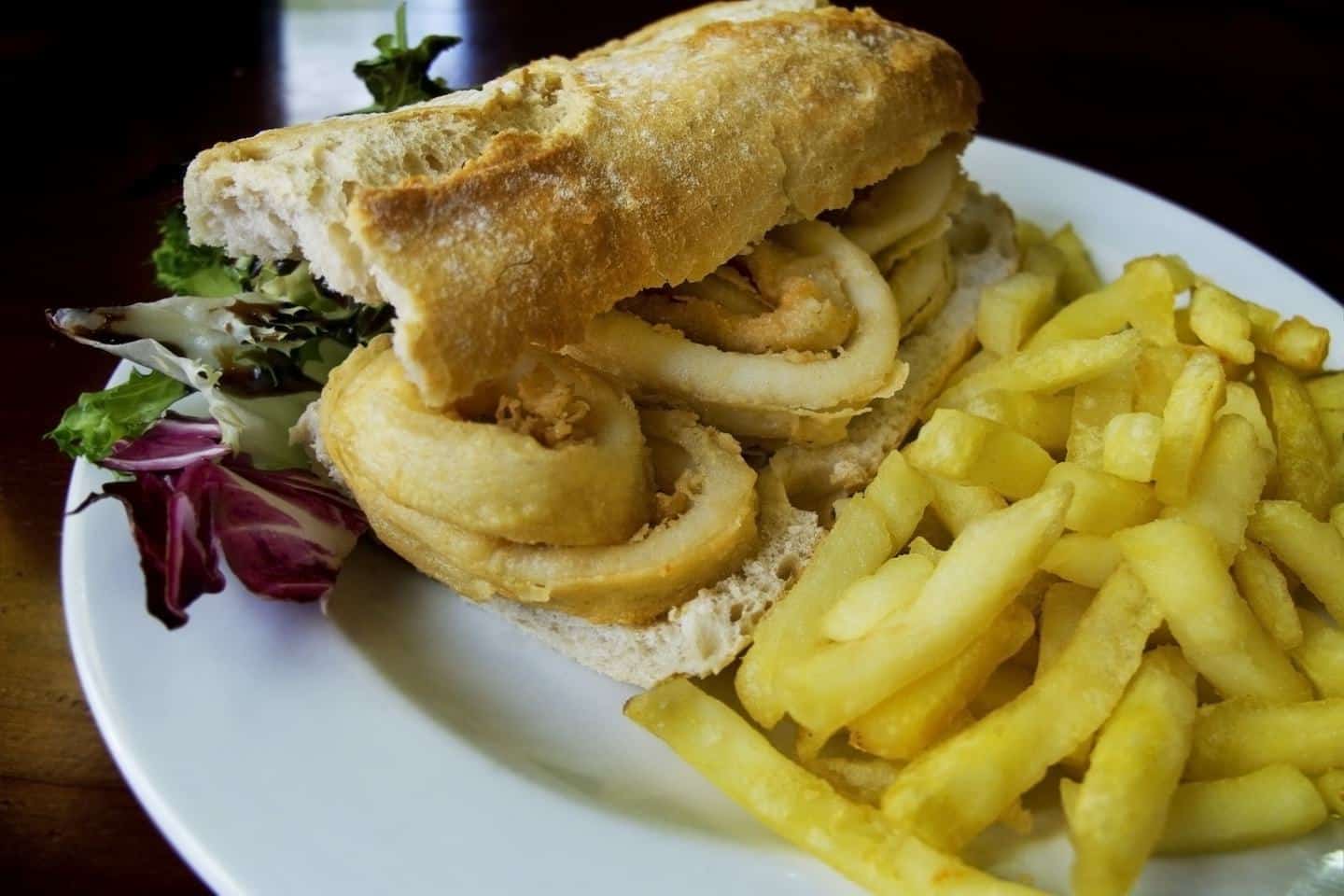
Ahh, the best quick meal there is in Spain. This grab-and-go sandwich is served on a Spanish baguette and is filled with local delicacies.
The most common fillings you’ll find are ham & cheese, potatoes, pork loin, and a Madrid specialty: fried calamari. This is the perfect bite to eat while you’re waiting for a famously late Spanish dinner or need some mid-day fuel to continue your city wandering!
Jamon Iberico

As the world’s largest producer of dry-cured ham, there’s no way you can leave Spain without munching on some jamon iberico. Iberico comes from black Iberian pigs, which is what makes it so different from other varieties of ham like serrano.
You’ll find this jamon hanging in full legs in tapas bars, meat shops, and restaurants. It’s served in super thin, fresh cut, melt in your mouth slices. *drools*
Chorizo
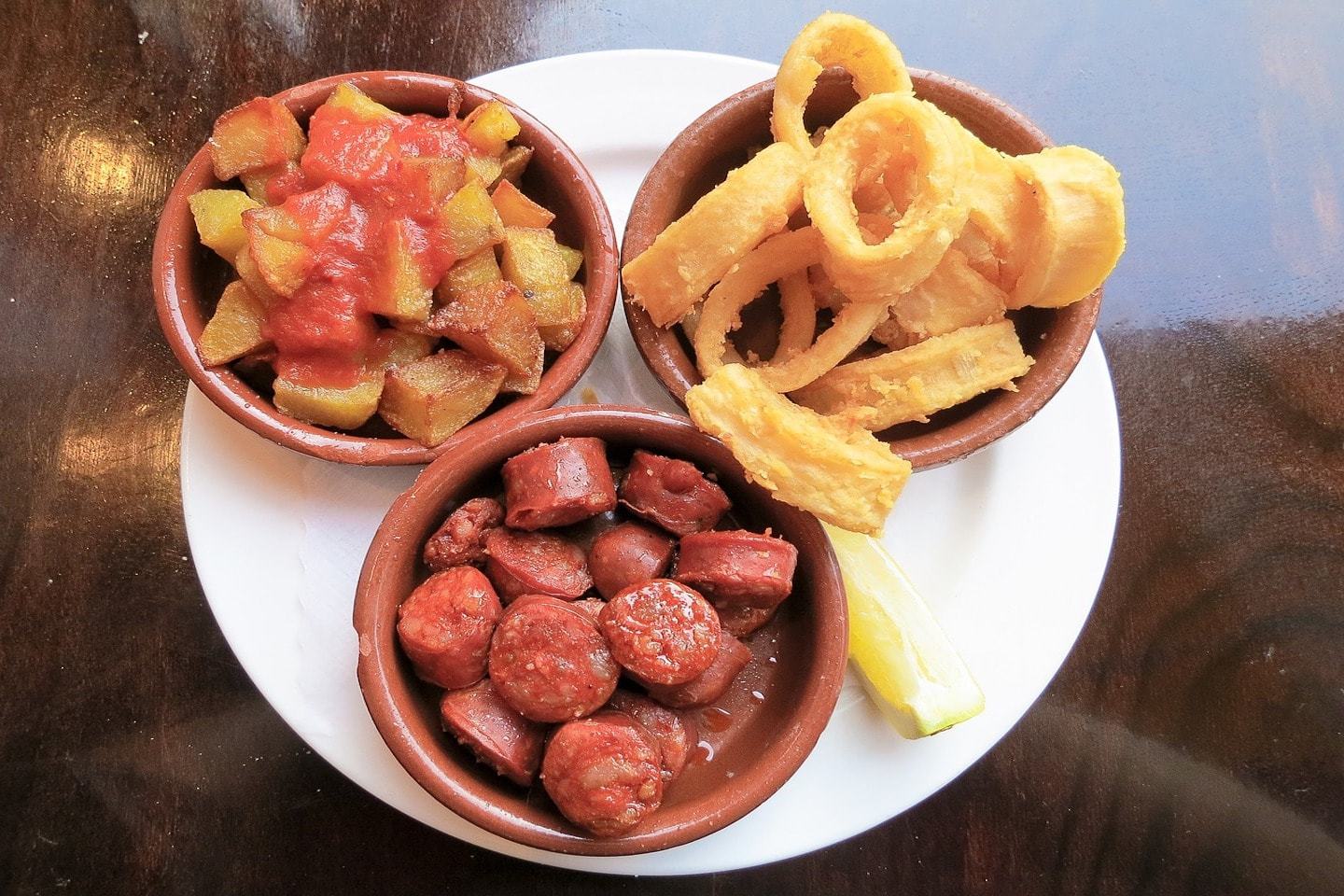
Another delicious Spanish pork product is chorizo. While you can find chorizo throughout the world, it doesn’t get any better than what you can find in Spain.
This fermented pork sausage has been cured and seasoned with Spanish spices to give it a little kick, while retaining some sweetness from the meat. It’s served in a wide variety of ways, whether dried and cut in slices with bread for tapas, lightly sauteed, or placed as a garnish on top of other dishes.
It’s extremely flavorful and extra delicious, so be sure to feast on it while you can!
Queso Manchego
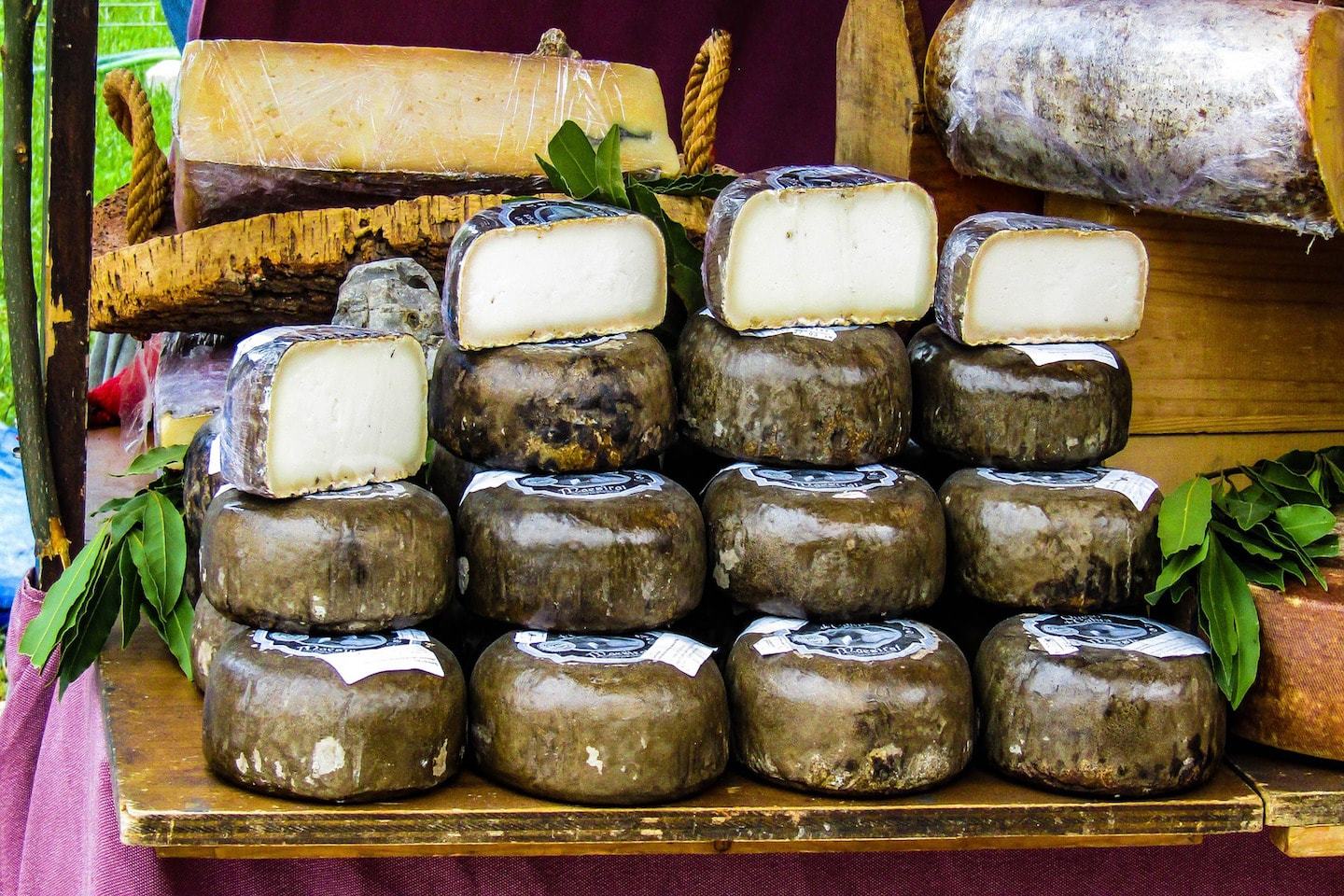
You can’t have your ham or pork without your cheese, now can you? That’s exactly why there’s a special Spanish cheese designed to go with whatever meat you’re snacking on.
Queso Manchego comes from the La Mancha region of Spain but can be found throughout the entire country. It’s sweet, nutty, and has a hint of earth to it, while staying semi-soft in texture. It’s often served alongside chorizo or jamon for some balance and will always leave you reaching for a little bit more.
Churros Con Chocolate
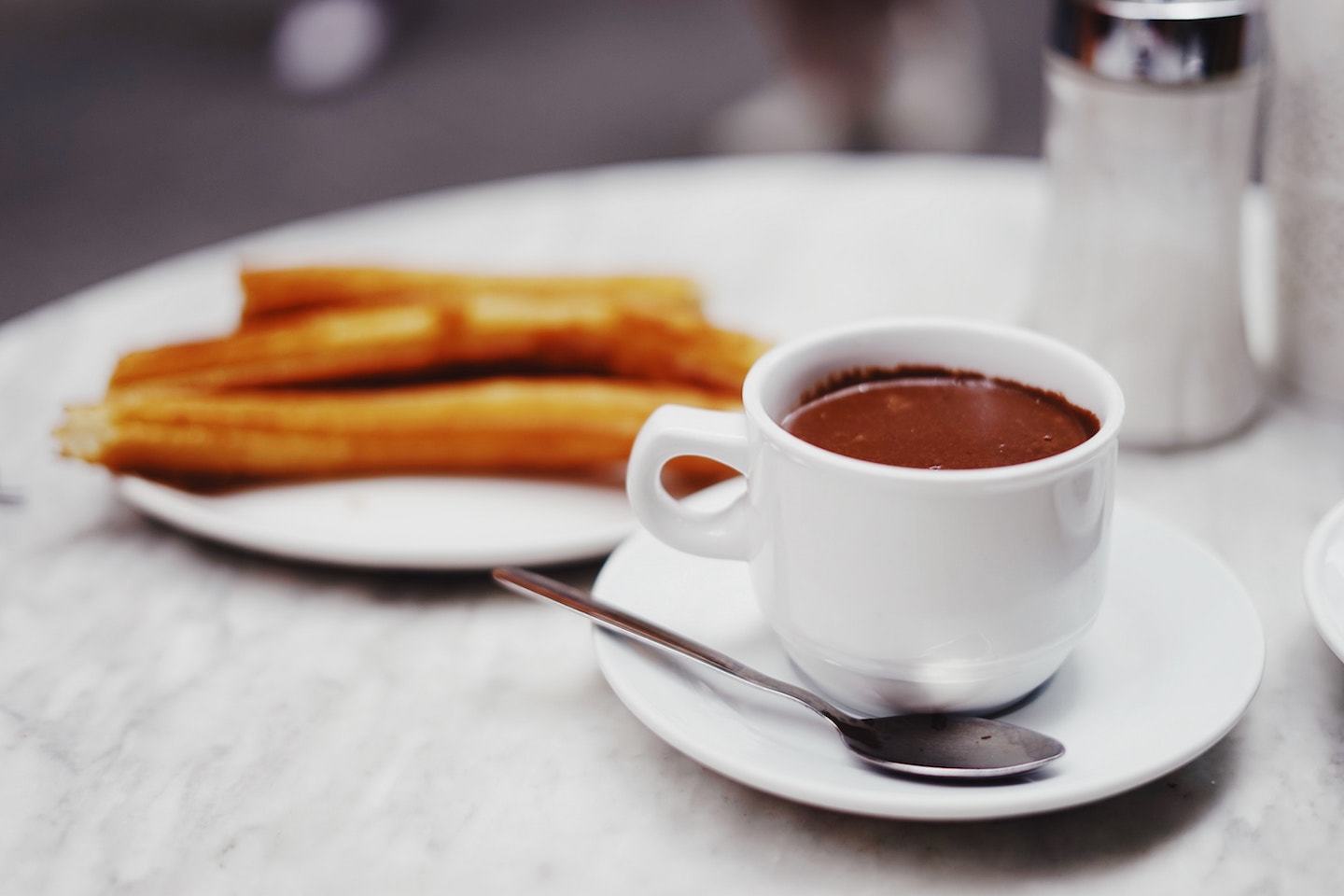
Time for dessert, wouldn’t you say? And it doesn’t get any more Spanish than a long, twisting churro with a generous helping of chocolate sauce.
You can find churros pretty much everywhere, from the finest restaurants to vendors on the side of the road, and they’re always equally delicious. They’re crispy on the outside, doughy on the inside and rolled in cinnamon and sugar.
My goodness, how can anything be as delicious as this?
The best way to eat these little babies is with the thick, warm Spanish chocolate sauce for dipping. Just be sure to ask for extra napkins — you’re going to need them!
Crema Catalana

While churros are certainly the most popular Spanish treat, Crema Catalana gives it some stiff competition for the best.
This may look like crème brûlée, but don’t get it confused. Instead of sweet vanilla custard, you get bursting flavors of orange and cinnamon, with a thin layer of caramelized sugar sitting right on top.
This dessert is served cold and is impossibly refreshing, so it’s a lovely treat to savor while you’re baking in the Spanish sun!
Sangria
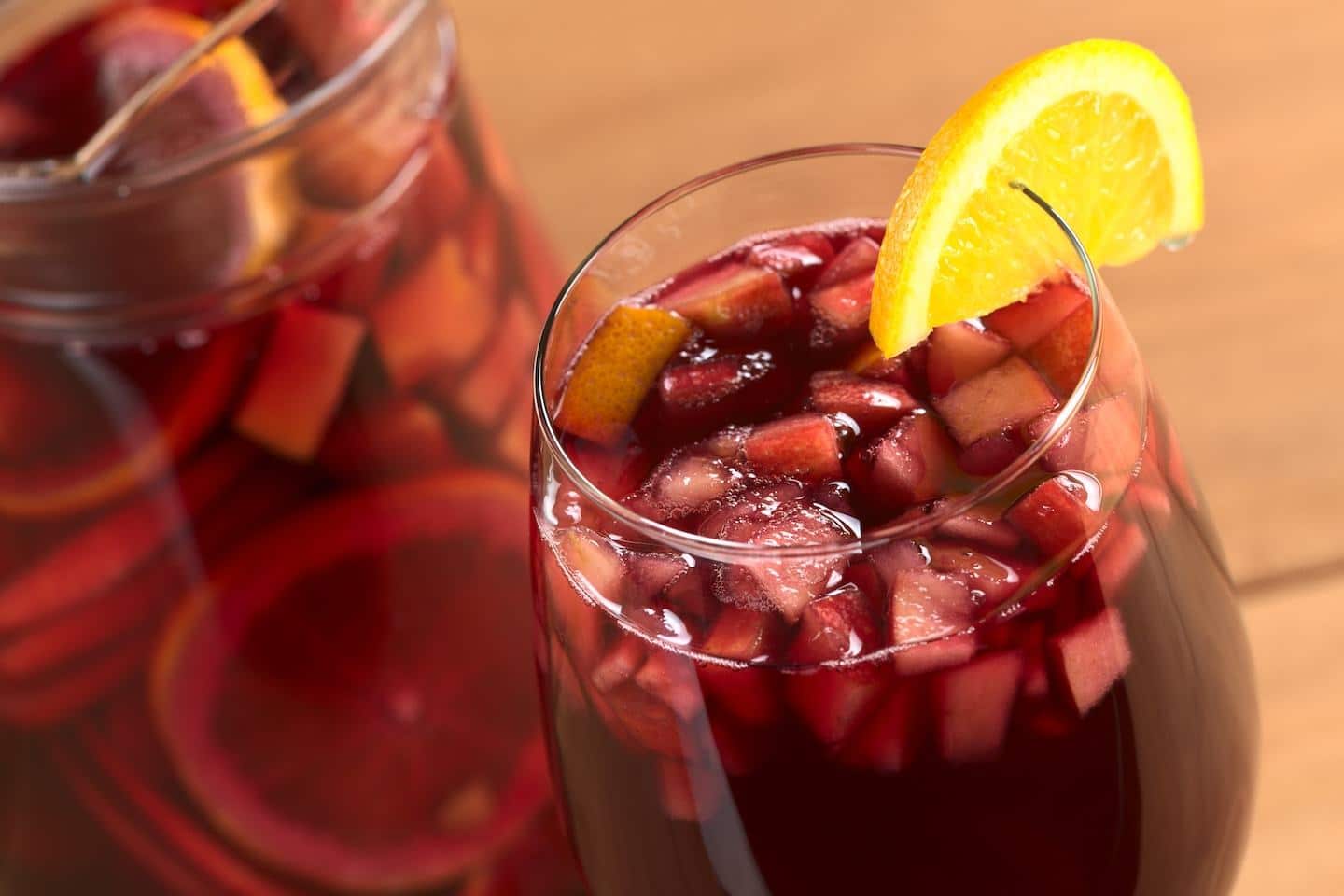
Okay, while technically a drink rather than food, you may find yourself digging around in your glass with a fork once you’ve downed the contents.
As the most popular drink in Spain, you’ll be able to find sangria pretty much anywhere you go. It has a red wine base but is mixed with a ton of other goodies like brandy, orange juice, and more!
Get it by the glass, enjoy an entire pitcher, and whatever you do, don’t forget to munch on the alcohol-soaked fruit at the end!
Tips for Dining in Spain
Knowing what to order is a great (and most important) first step, but here are a few other things you should know when it comes to dining out in Spain.
Must-Know Spanish Dining Terms
You don’t really need to know Spanish to get by in Spain, but it’ll certainly give you a lot of street cred with the locals and help you read menus.
Here are some must-know dining terms that can really help you get the most of your eating experience in Spain!
How to Read a Spanish Menu
Entrantes – Appetizers for sharing
Primeros – First courses, typically during lunch and generally vegetables
Segundos – Second courses, also only typically during lunch, and generally meat or fish dishes
Tostas – A slice of baguette toast with delicious toppings like meat or cheese
Carnes – Meat dishes
Aves – Poultry dishes like chicken, duck or turkey
Ensaladas – Salads
Postres – Desserts (aka the most important part of the menu)
A la brasa – Charcoal grilled
Ración – Shared plate
Menu del dia – Menu of the day, a set menu for lunch that’s generally three courses
Cana – Small serving of beer on tap (typically 200ml or 7oz)
Doble – A little larger than a cana (typically 350ml or 12oz)
Solo – A single espresso
Cortado – A shot of espresso with a splash of hot milk, normally enjoyed following lunch or dinner
Con leche – Coffee with milk, normally for the morning
Psst...Want in on a Secret? 🤫

We've scoured the internet for the best ALL-AROUND travel shoe and Tropicfeel wins by far. We've taken ours through rivers, jungles, and cities and they're still alive and kickin'. Check them out below.
Spanish Words & Phrases to Know When Dining Out
Restaurant – Restaurante
Waiter / Waitress – Camarero / Camarera
Table – Mesa
I would like… – Quisiera…
May I have the bill please? – La cuenta, por favor
Thank you – Gracias
I am a vegetarian – Soy vegetariano
Water – Agua
Restroom – Bano
Bon Appetit! – Buen provecho!
Dining Etiquette in Spain
As I’ve mentioned, dining in Spain is a sharing experience. Typically, meals are enjoyed slowly with many rounds of small plates ordered to be shared among the table. People drink, talk, laugh, and have a good time until they’re finally full from the bite-sized portions.

One thing that may be a bit strange to a foreigner eating in Spain is that bread is always served, but often times without butter and without a bread plate as well. To blend in with the locals, simply grab a piece of bread and place it on the side of your main plate or on the table next to your dish. Use it to scoop up food or sauces, and enjoy!
A final note you should keep in mind about dining in Spain is that Spaniards like to eat late. Now, I’m not talking about coming home from work, watching some TV, and then finally preparing your dinner at around 8pm.
No, Spanish people wait until the sun goes down and start dining between 9pm and 11pm — sometimes even as late as midnight. This means that meals can last into the wee hours of the morning, but that’s part of the fun!
Tipping in Spain
Like with most other European countries, tipping in Spain is not expected or required. The restaurant staff are paid a livable wage and have things like healthcare and benefits, rather than making a living off what guests leave them.
That said, if you’ve had an exceptional meal with great service, leaving behind a few coins or small bills is always greatly appreciated.
Other Tips & Tricks for Eating in Spain
Here are a few other tips and tricks to make the most out of your Spanish dining adventures!
Get Treats When You Drink
Oftentimes you’ll find that when you order a drink at a bar or restaurant, you’ll end up with small snacks like olives or chips to go along with it. On occasion, if you’re in the Basque Country or Andalusia, you’ll even end up with a free tapa to snack on while you sip!
Deals like these are awesome for happy hour so you can have a quick bite while you hungrily await dinner.
Take a Food Tour!
One of the best ways to experience all local delicacies is to take a food tour while in Spain. You can find tours in pretty much every city like Madrid, Seville, Valencia, Malaga, Barcelona, and more!
If you’re in Barcelona, check out our picks for the best Barcelona food tours.
You’ll have a local guide well-versed in Spanish cuisine take you from place to place where you’ll get to taste a little bit of everything. The best part is that most food tours involve walking to each new destination, meaning you can make some room in your belly between stops.
After a food tour, you’ll be set to venture out on your own to try your favorites again and discover new things as well!
Cooking Classes in Spain
Want to take your knowledge of Spanish food even further? Then try taking a cooking class while in Spain. Check out cooking classes on Cookly — we’ve taken their cooking classes in various places around the world and would highly recommend them!
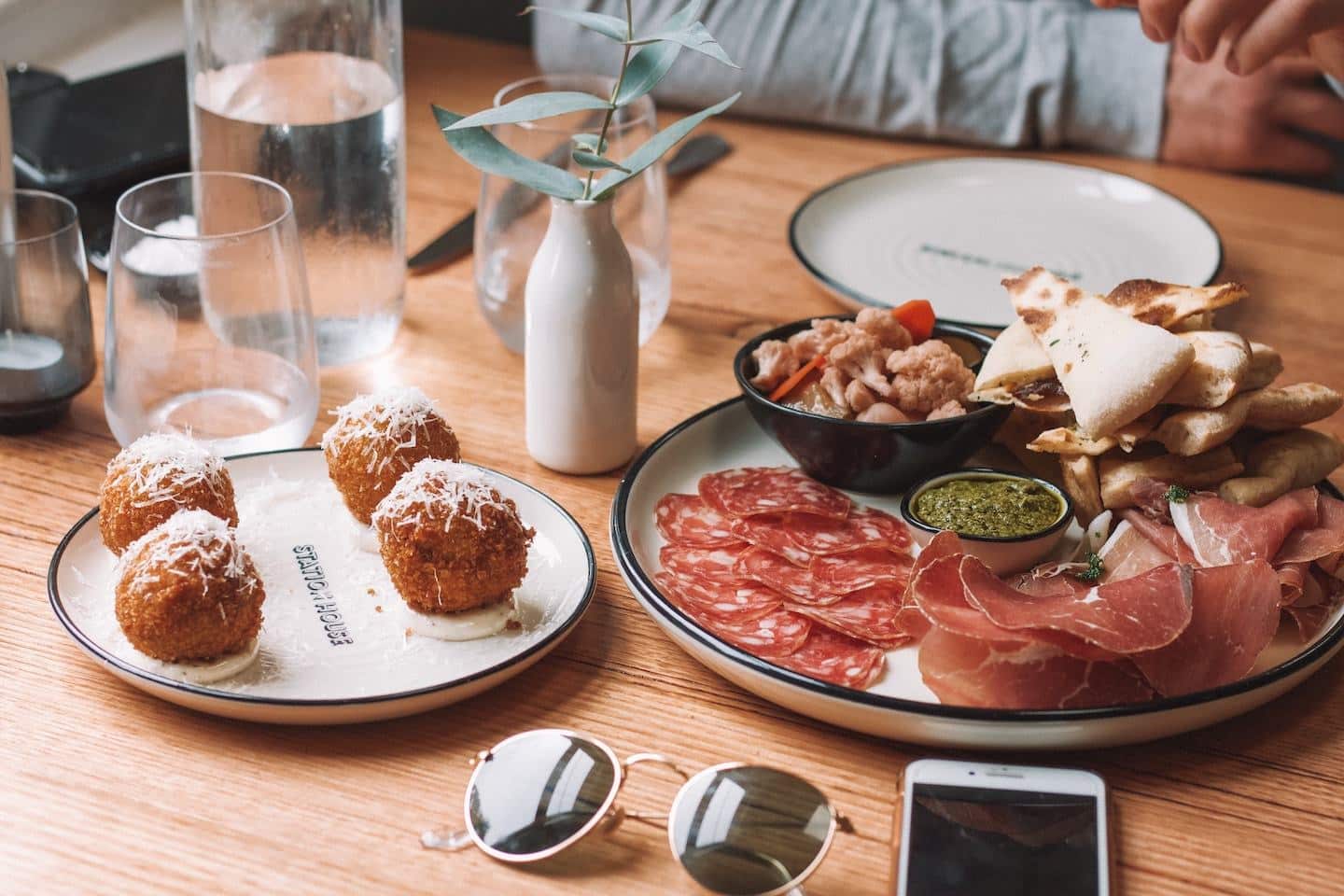
Eat On a Spanish Schedule
You’ll find that you’ll get on quite well if you eat on a Spanish schedule.
Typically, breakfast is eaten sometime in the morning, and then lunch isn’t until between 2pm and 5pm. This means that there’s plenty of time for snacking in between breakfast and lunch, which is a great way to try more food outside of standard meal times!
Following lunch, you’ll find that most restaurants don’t even open again until around 8pm when dinner service begins. Most locals don’t have their final meal of the day until around 10pm, so you’ll have the best luck finding a seat between 8pm and 9pm.
Go For Spanish-Only Menus
While it may be daunting, try to eat only at places with pure Spanish menus. It may be tempting to flock to a restaurant with English listings, but you’re much better off going somewhere that’s more local and less catered towards tourists. The food will be inevitably better, trust me!
When checking menus, you should also keep your eyes out for inserts or chalkboards listing a menu del dia. This is a menu with different options to choose from at a set price, and you really can’t go wrong no matter which set you choose. It’s only offered at lunchtime and typically only on weekdays as well, but it’s a deal that simply can’t be missed.
A menu del dia generally come with three courses and cost between 8 to 14 euros. What a steal! You can expect it to come with extras like a drink, salad and dessert.
Food is Worth Traveling For in Spain
A final tip is to travel for food if your itinerary allows you to.
Head to the coast for the freshest fish of your life, or Valencia for the birthplace of paella. Of course you can find most dishes anywhere in the country, but there’s truly nothing like going directly to the source for something you love.
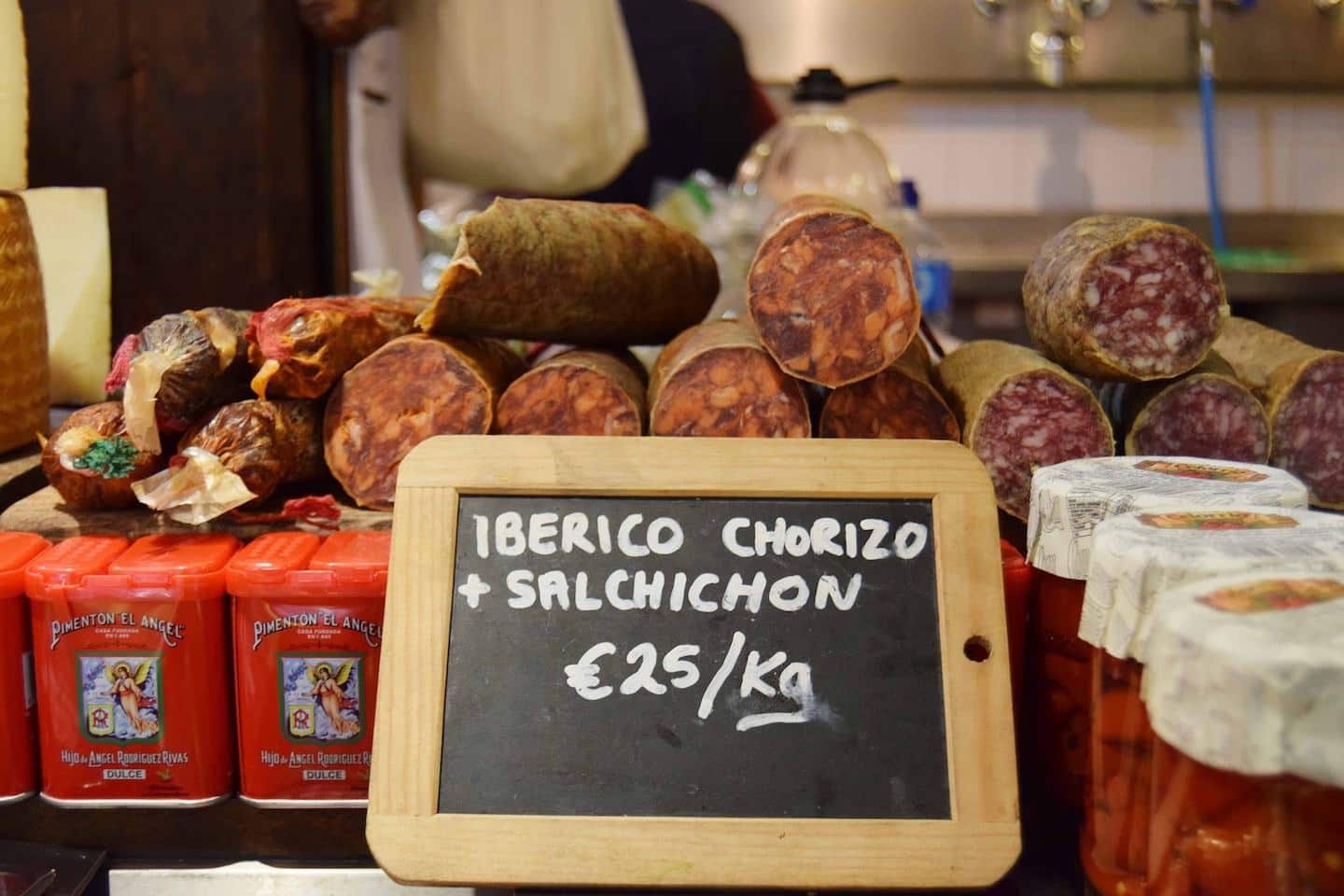
After reading about all the succulent, delectable, and oh-so delicious foods of Spain, aren’t you just dying to get out there?
From all the different options, bites, spices, and drinks to wash it down, there’s no greater cultural experience than dining in Spain. With a single taste, you can be transported to a different region, and practically imagine locals preparing the delicate but hearty food with nothing but love.
When it comes to food around the world, Spain is one of the best places to indulge. So what are you waiting for? It’s time to start eating some tapas!
Where to Stay in Spain
Looking for tips on where to stay while in Spain?
Where to Stay in Barcelona
Where to Stay in Valencia
Where to Stay in Bilbao
Where to Stay in San Sebastián
Where to Stay in Seville
Where to Stay in Granada
Where to Stay in Tarifa
Where to Stay in Marbella
Where to Stay in Malaga
Where to Stay in Mallorca
Hopefully, this article has helped you uncover the fantastic world of Spanish food! Happy eating.
Planning a trip to Spain? Check out these articles!
- Best Places to Visit in Spain That You Shouldn’t Miss
- The Best Beaches in Spain for the Ultimate Seaside Holiday
- Where To Stay in Spain | Best Hotels & Hostels
Inspired? Pin It!
